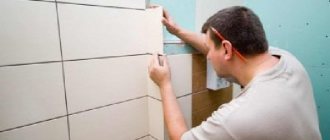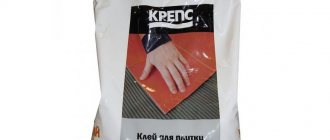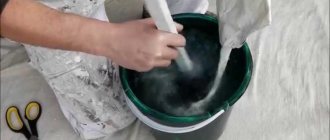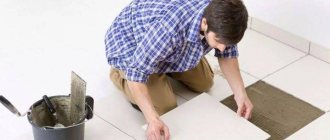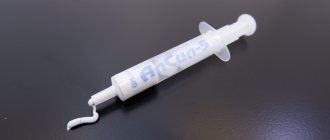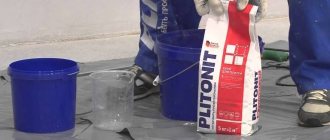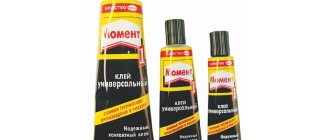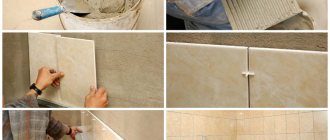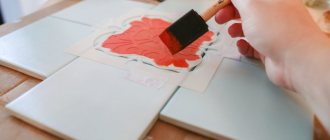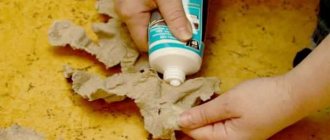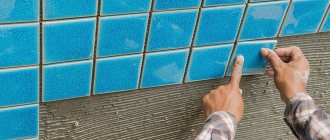One of the well-known names among tile adhesives is KREPS. Bright packaging attracts the eyes of buyers. It is necessary to understand which mixture among the variety presented, first of all, to pay attention to. KREPS “Reinforced” adhesive for tiles and porcelain stoneware has certain features that are worth talking about in more detail.
Brand information
The KREPS company began its activities in the late nineties, more than 20 years ago. Since that time, it has launched the production of dry mixtures used in construction. Today the company has the status of a federal manufacturer. There are two large factories in the Russian Federation, located in the Urals and St. Petersburg.
Among the products of this company, more than 50 types of goods can be distinguished. This list includes KREPS adhesive for tiles, main types of plaster, putties, dry mixtures with the main component of cement, special leveling solutions for damaged floor coverings and much more.
All products undergo strict testing before going on sale. Thanks to this, the risk for consumers of purchasing low-quality building materials is reduced to almost zero.
Features and advantages of the KREPS brand
To find out what strengths dry adhesives from the KREPS company have, you need to consider their compositions.
Standard components are:
- Cement.
- Various modifiers.
- Sand.
- Additives for plasticization.
Before you start working, you need to prepare the adhesive mass. To do this, the dry powder is diluted with water according to the proportions indicated on the packaging.
If the solution is mixed correctly, it will have the specified technical characteristics of tile adhesive:
- Brand strength – M 75.
- Adhesive strength – 1 MPa.
- Frost resistance index – F 35.
KREPS tile adhesive under the “Reinforced” brand has parameters that are higher than those of dry mixes under the name “Standard”. In addition, after mixing the composition, you can work with it for 20 minutes longer. The reinforced composition tolerates temperature changes, thanks to this, you can work with it outdoors or at home when installing a “warm floor” system.
In addition to the improved characteristics presented above, KREPS “Strengthened” adhesive has other advantages.
These include:
- High frost resistance.
- Long-term moisture resistance.
- Economical due to low consumption.
- Sets quickly.
A separate group of adhesives is modified with additional additives to improve the basic characteristics. These can be fireproof substances, antifreeze.
Advantages and disadvantages
Kreps reinforced glue has won the trust of customers thanks to the following positive qualities:
- The main advantage is a high degree of adhesion to surfaces.
- Resistant to slipping.
- Withstands both low and high temperatures. It can be mounted on a heated floor, used for lining stoves and fireplaces, without fear of the tiles peeling off.
- Waterproof - suitable for tiling work in rooms with high humidity (showers, etc.)
- Affordable price with high quality.
- Sets quickly - about 10 minutes. Dries in 2-3 days.
- Economically used. Sold in bags weighing 25 kg. The average glue consumption is 2-3 kg per sq.m. Thus, one bag is enough to cover a surface area of 8 sq.m. These are approximate figures, since the amount of solution depends on the condition of the surface and experience in facing work.
The disadvantages of tile adhesive include the need for experience working with it. If you do not apply enough adhesive to the surface, the tile will fall off. If there is too much glue, it will start to slip.
Advice! Why should you not use conventional adhesive solutions in extreme conditions? They lack elasticity and resistance to temperature changes, which can cause damage to the facing coating. For example, when using conventional adhesive to finish a heated floor, cracks will appear on the coating after just a few heating and cooling cycles.
Application area
KREPS “Reinforced” adhesive has improved technical characteristics. Thanks to this, the scope of its application is expanding. The mixtures can be used when finishing rooms with ceramic tiles and large porcelain stoneware slabs. This glue is suitable for working with natural or artificial stone.
KREPS adhesive composition is used for laying decorative coatings on various substrates:
- Concrete screeds (“warm floor”).
- Drywall, gypsum boards.
- Any types of plaster.
High levels of frost resistance and moisture resistance allow finishing of the external sides of buildings.
Types of KREPS adhesive for tiles
Tile adhesive of the KREPS line from one of the leading companies has many names. The corporation sells several items that have varied characteristics. We need to talk about them in more detail.
Area of use
Using glue, you can lay various types of tiles: porcelain stoneware, elements made of marble, mineral materials, large-format heavy products. The product is excellent for finishing ceramics and the following types of tiles:
- floor,
- wall,
- façade,
- sidewalk,
- decorative,
- mosaic,
- for heated floors.
Only when installing slabs larger than 60*60 cm at a height of more than a meter is it recommended to do additional fixation. In other cases, the use of Kreps glue is sufficient to securely secure the finish. Using glue you can work with tiles on the following substrates:
- cement, concrete (including cellular), reinforced concrete,
- cement-lime plasters,
- drywall and plasterboard,
- tongue-and-groove slabs,
- limestone coverings,
- brick, other porous mineral bases.
The applications of glue are varied; it is considered a universal product. “Kreps” is used in houses, apartments, offices, and helps to finish floors and walls in industrial buildings, workshops, and utility rooms. The material is also useful for finishing sports facilities, terraces, open areas, paths, bathrooms, baths and saunas. Water resistance allows it to be used for lining swimming pools.
KREPS “Reinforced” 25 kg
KREPS “Reinforced” tile adhesive 25 kg, which can be found in any specialized store. Recommended for finishing work with ceramic tiles, porcelain stoneware slabs, and other decorative materials.
This tile adhesive is well suited for working both on the inside of walls and on the outside (outside of buildings). Designed for laying slabs on almost all vertical and horizontal prepared surfaces.
List of such places:
- Gypsum boards.
- Any types of plaster.
- Cellular concrete.
- Screeds (“warm floor”).
- Fireplace cladding.
- Drywall.
Specifications:
- The time until the solution hardens is 4 hours.
- The time period for adjusting the position of the tiles is 20 minutes.
- Temperatures for using the finished composition are from 0 to +25 degrees.
- Average consumption of KREPS “Reinforced” glue per 1 m2 ~ packaging per 8 m2.
Grouting work is carried out no less than 24 hours later. After grouting, the surface will be ready for use.
Main characteristics
This binder mixture is created specifically for porcelain stoneware and ceramic tiles. It consists of fractionated sand and cement. When combined with water, an elastic mass is formed. Reinforced creps is not afraid of moisture and water, has excellent adhesion and is resistant to frost.
This type of glue is suitable for exterior and interior decoration. It adheres well to cement, concrete, plasterboard, tongue-and-groove and gypsum boards. This mixture can be used for surfaces with high levels of heat transfer, for example, for facing a fireplace. Using Kreps reinforced with antifreeze additive, you can perform styling at temperatures down to -10 degrees. Despite the fact that the glue has excellent bonding characteristics, installation of tiles with an area of 400x400 or porcelain stoneware 8 mm thick at a height of 1 m will require additional fastening.
KREPS glue “White reinforced” 25 kg
KREPS products with improved characteristics. Its key feature is white color. Due to this, it is used for laying glass tiles. Used for finishing work with ceramic and porcelain tiles. Due to its increased resistance to high and low temperatures, it is possible to use adhesive for screeds with installed “warm floors”.
Used for laying slabs on different surfaces. List of such places:
- Gypsum boards.
- Any plasters.
- Cellular concrete.
- Warm floor screeds.
- Drywall.
Specifications:
- The average consumption of the finished mixture is 2 kg per 1 sq.m.
- The time until the solution hardens is 4 hours.
- The time period for adjusting the position of the tiles is 15 minutes.
- Temperatures for using the finished composition are from 0 to +25 degrees.
Grouting work should be carried out after 2 days.
The solution is suitable for lining the internal walls of swimming pools, fireplaces, and external walls of buildings.
KREPS glue “Reinforced winter” 25 kg
To perform facing work, use tile adhesive “Winter” KREPS. Intended for laying ceramic tiles and porcelain stoneware slabs. The main value of the adhesive composition is the stability of the installation quality at low temperatures, as well as to the effects of dampness and moisture. Thanks to this, it is better suited than others for finishing buildings outside.
Used for laying slabs on a variety of surfaces. Which include:
- Gypsum boards.
- Different types of plaster.
- Cellular concrete.
- Warm floor screeds.
- Drywall.
Specifications:
- The average consumption of the finished mixture is 2 kg per 1 sq.m.
- The time until the solution hardens is 4 hours.
- The time period for adjusting the position of the tiles is 15 minutes.
- Temperatures for using ready-made glue are from -10 to +25 degrees.
After 24 hours it is necessary to grout the joints. It is allowed to use the finished surface no earlier than after 24 hours.
CREPS “Super” 25 kg
The adhesive is allowed for finishing work outside premises, as well as inside buildings. Used for laying ceramic tiles and porcelain stoneware. The main feature of this adhesive composition is the presence of special polymers that improve the characteristics of tile adhesive.
Used for laying slabs on a variety of surfaces. List of such places:
- Gypsum boards.
- Different types of plaster.
- Cellular concrete.
- Metal, wood.
- Different types of plastic, glass plates.
- Screeds with “warm floor” systems.
- Drywall.
Specifications:
- The average consumption of the finished mixture is 25 kg per 8 sq.m.
- The time until the solution hardens is 4 hours.
- The time period for adjusting the position of the tiles is 20 minutes.
- Temperatures for using the finished composition are from +5 to +25 degrees.
Grouting should be done no earlier than 48 hours. After this, the surface is ready for use.
KREPS "Express" 25 kg
A cement-based dry mixture, which is recommended for quick finishing of ceramic and clinker tiles, porcelain stoneware. The composition is supplemented with special modifiers that improve technical characteristics. The glue is resistant to low temperatures and prolonged exposure to moisture.
Used for laying slabs on a variety of surfaces. Which include:
- Gypsum boards.
- Different types of plaster.
- Cellular concrete.
- Screeds with “warm floor” systems.
- Drywall.
Specifications:
- The average consumption of the finished mixture is 25 kg per 8 sq.m.
- The time until the solution hardens is 4 hours.
- The time period for adjusting the position of the tiles is 15 minutes.
- Temperatures for using the finished composition are from +5 to +25 degrees.
Seams must be treated after 24 hours. Before this period of time has expired, the surface cannot be used. As the name and technical data indicate, this composition will help save time when needed.
Litokol Litoplus K55
Volume : 25 kg.
Price : 787 rub.
Renovating an apartment is always a big expense; you want everything to be done efficiently. But sometimes you can save money, because today is the time when you can read reviews from customers who managed to buy a cheap but high-quality product. Litokol Litoplus K55 is a good and relatively inexpensive (compared to others) glue.
We can roughly highlight its main advantages:
- white consistency;
- freezes well;
- holds perfectly;
- has no smell.
Litokol Litoplus K55 glue is a real find for those who decide to start a renovation! It does not emit the unpleasant odor characteristic of many adhesives, and it is quickly washed off the tools. The glue hardens quickly and well - do you really need anything else from the glue?
Glue KREPS “Basic” 25 kg
A cement-based dry mixture, which is intended for laying porcelain stoneware and ceramic tiles.
Porcelain stoneware slabs should not exceed 300x300 mm in size.
It is used for work both outside buildings and indoors. Used for laying slabs on various surfaces.
List of such places:
- Different types of plaster.
- Cellular concrete.
- Screeds with “warm floor” systems.
Specifications:
- The average consumption of the finished mixture is 25 kg per 8 sq.m.
- The time until the solution hardens is 4 hours.
- The time period for adjusting the position of the tiles is 10 minutes.
- Temperatures for using the finished composition are from +5 to +25 degrees.
Grouting of joints must be done after 48 hours.
However, use of the surface is allowed only after 72 hours.
CREPS “Standard 0.85” 25 kg
Tile adhesive from the KREPS company, which is used for laying ceramic tiles and porcelain stoneware. Suitable for work both inside and outside buildings.
Porcelain stoneware slabs should not exceed 600x600 mm in size.
Used for laying slabs on certain surfaces. List of such places:
- Any types of plaster.
- Cellular concrete.
- Warm floor screeds.
Specifications:
- The average consumption of finished glue is 25 kg per 8 sq.m.
- Time until hardening is 4 hours.
- The time period for adjusting tiles is 10 minutes.
- Temperatures for using ready-made glue are from +5 to +25 degrees.
Grouting robots must be carried out after two days.
Operation of the finished base only after 3 days.
Preparation and storage of KREPS solution
After choosing KREPS tile adhesive, you need to learn how to properly mix the dry mixture and store the unprepared composition in an already opened package. Before you begin preparing the working solution, you need to prepare the tools for mixing the mixture.
These include:
- Mixing container.
- Water, adhesive composition.
- Putty knife.
- Drill with mixer attachment.
Preparation of glue from the KREPS company:
- Fill the mixing container with water. The amount of liquid depends on how much finished tile adhesive you need to obtain. The proportions are indicated on the packaging.
- Pour the amount of dry mixture required according to the instructions into the water, and not vice versa.
- Using a drill or spatula, thoroughly mix the solution. There should be no lumps or dry areas of the mixture left.
- Wait 15 minutes, mix the composition again.
Prepare the solution immediately before use. After mixing, the finished adhesive must be used within 4 hours.
After this period of time, it will lose its adhesive (working) properties.
Cover the remaining dry mixture tightly and store in a dry place.
How to work with composition
How to prepare an adhesive solution:
- Pour 5-6 liters of clean water into a basin or deep bucket.
- Next add one pack of mixture (25 kg).
- Mix the solution using a hammer drill with a special attachment or manually. There should be no lumps left in the mass.
- Now you need to let the glue sit for 10 minutes.
- Mix the composition again.
- The glue is ready. It must be used within 4 hours after preparation. The composition is stored only at room temperature; if the conditions are violated, it will lose its properties.
Before starting installation on “Kreps reinforced”, it is necessary to carry out preparatory procedures:
- the surface is cleaned of dust and dirt,
- level,
- degrease,
- primed.
What you should know about installation work with reinforced adhesive:
- All operations are carried out only at positive temperatures.
- The surface should not be subject to shrinkage or deformation.
- A notched trowel is used to apply the adhesive to the surface. If the tile has a size of 15x15 cm, then take a spatula with 6 mm teeth; for tiles measuring 30x30 you will need a spatula with 8 mm teeth.
- The optimal glue layer is no more than 4 mm. If the tile is more than 300×300, then the layer is increased to 7 mm.
- If the floor is uneven, then the glue is applied in a layer of up to 9 mm, and the evenness of the surface is controlled using a level.
- It is recommended to attach the tiles within 10-20 minutes after applying the adhesive, as it has the ability to set quickly. Time allows you to adjust the position of the tile.
- After installation, the wall dries in about 2 days, the floor - 3 days. After this time, grouting is allowed.
- Do not walk on the floor until it is completely dry. In general, it is not recommended to subject drying surfaces to mechanical stress or allow them to come into contact with water.
- When working, you must use personal protective equipment.
- If the product gets on your skin or eyes, rinse thoroughly with clean water.
In some cases, you cannot do without Kreps reinforced glue. The composition can be trusted to install large elements on non-standard surfaces. Subject to all working conditions with glue and surfaces, the facing materials will hold tightly for many years.
Working with KREPS tile adhesive
When the tile adhesive is ready to use, you need to learn how to apply it to the working base and facing tiles.
Stages of work:
- Initially, the base is prepared for laying. It needs to be leveled and old tiles removed. Clean from dust, oil stains and prime.
- After the preparatory work, you need to apply the prepared solution with a notched trowel to the base.
When the laying is completed, the tiles should not be subjected to mechanical stress for 24-72 hours (depending on the selected KREPS brand).
If we are talking about working with large slabs, it is necessary to apply the tile adhesive mass not only to the base, but also to the slabs.
Useful tips for masters
It will be useful for people who are laying tiles for the first time to learn recommendations from experienced craftsmen.
These include:
- It is important to choose the correct thickness of the applied adhesive layer. The best option is a layer of 4 mm.
- When the size of the tiles exceeds 300x300 mm, it is required to increase it to 7 mm. If the working base has unevenness, it is necessary to make a larger layer - from 9 mm.
- You need to choose tools depending on the size of the tiles. For example, if individual elements do not exceed 15x15 cm in size, you must choose a spatula with 6 mm teeth.
- It is not advisable to start grouting joints located on the walls earlier than 48 hours after laying the slabs.
If glue gets on your skin, you must rinse the contaminated area under running water. Work in special clothing. This is standard safety precautions.
Useful tips
To work with glue efficiently, you need to listen to the advice of professionals:
- After the main stage of work, you need to wait at least 48 hours for the walls, but for the floor you will have to wait 72 hours until the composition completely hardens; loading the surface earlier and starting grouting is highly not recommended.
- The larger the tile size, the larger the trowel teeth are needed for leveling. For example, for a 15x15 cladding, a length of 6 mm is suitable, but for a 30x30 material, 8 mm is already needed.
- When applying glue, you need to monitor the thickness of the layer. The optimal size would be up to 4 mm. When the cladding is more than 30x30, the layer should be larger - 7 mm. When finishing the floor, you can make the layer even thicker - 9 mm. However, in any case, the material must be applied evenly over the entire surface. For convenience, a level is used.
- When working with glue, you must follow safety precautions. It is important to use protective equipment in the form of gloves and a mask. Sleeves should be long to avoid exposed skin.
Work should not be carried out at sub-zero temperatures. The optimal indicator would be +5 degrees, but you can start from zero. It is best to use a notched trowel for application, so as not to further level the surface with other tools. The base on which the product is applied must be flat and not subject to deformation or shrinkage.
Do not step on the floor immediately after finishing. You need to wait a certain time for the glue to dry completely. While drying is taking place, the surface must not be washed, that is, contact with liquids and mechanical factors must be avoided.
Reference! It is necessary to fix the tiles as soon as possible after applying the product, without waiting until a few minutes remain before the glue becomes unusable.
Reviews of KREPS adhesive compositions
Valery 42 years old
I have been working in finishing for over 10 years. I most often practice with tile work. Many times I have come across low-quality adhesives that are extremely inconvenient to work with. In addition to poor-quality mixing, they do not hold the tiles well and take a long time to dry. Over time, the finished surface quickly deteriorates under the influence of physical stress or moisture, as well as rising and falling temperatures. I've been using KREPS glue for about a year. I used it for the first time while working with porcelain tiles. The reinforced adhesive composition is easy to use and firmly holds decorative materials on the walls or floor. The price is lower than many famous brands.
Maxim 37 years old
This was my first time renovating my own home. It was necessary to lay tiles in the bathroom, toilet, and kitchen. For a long time I was deciding which glue was best to choose. Many of the dry mixes sold in hardware stores were confusing. After reading the opinions of experienced tilers, I chose KREPS Reinforced tile adhesive. The mixture is easy to mix and convenient to apply. It was inconvenient to lay the first slabs due to lack of practice. After some time, namely after 2 finished walls, the work went faster. The seams were sealed as indicated on the package - after 48 hours. I really liked the glue, I have no complaints about working with it.
Evgeniy 39 years old
I laid tiles at home several times, sometimes with close relatives. I came across the problem that not all adhesives are good and of high quality, i.e. meet all requests. For example, when I worked with porcelain stoneware outdoors, I used universal glue. But the finished foundation remained intact until the onset of the first serious frosts, then it was destroyed. Familiar finishers advised me to buy KREPS glue. I have used different names of this company 4 times. I can say that it is convenient to work with it, the solution is consumed slowly. If you work at home, it is enough to make a layer of no more than 5 mm to get a reliable connection.
Drawing conclusions
In the last article, Litokol adhesive for tiles was discussed in detail. This brand has, perhaps, the largest assortment among all companies, about 20 items for facing work.
KREPS Corporation develops adhesive mixtures in its laboratories using modern equipment. Technologists are constantly studying and introducing innovations in the field of chemical components that improve product quality. They study the best practices of European manufacturers, so KREPS brand compositions are environmentally friendly and easy to use.
Question answer
Answers to frequently asked questions.
Floor levelers
Question: Hello, can you tell me whether the KREPS BMP 2in1 self-leveling floor has good fluidity, and whether a needle roller is enough to evenly distribute the mixture over the floor.
Answer: Good afternoon. The mobility of the KREPS BMP 2in1 leveler is good. To better understand what we are talking about, you can watch our video clip. This video uses the KREPS SV leveler; it has the same mobility as the KREPS BMP2v1.
Question: Good afternoon! Please tell me, can the KREPS “BMP 2in1” self-leveling leveler be used for wet rooms such as a bathroom?
Answer: KREPS BMP 2in1 can be used for wet rooms (for example, under the finishing coat in a bathroom), but not for filling a shower stall.
Question: Hello. I would like to clarify with you if you pour KREPS GRU self-leveling floors, will such floors be moisture resistant and are such floors afraid of flooding? Thank you in advance.
Answer: Good afternoon. KREPS GRU contains gypsum; for this reason, exposure to direct water contact can lead to a significant decrease in strength and cracking of the material.
Hello. Tell me the self-leveling floor KREPS "GRU" it is: 1 on a gypsum base, 2. is it suitable for weak bases, 3. can it be used in the kitchen? KREPS “Remsostav” - 25 kg, can 3 layers be poured in 40mm? Thank you in advance.
Answer: Hello!
1. KREPS GRU based on a complex cement/gypsum binder, but the gypsum component predominates.
2. The concept of a weak foundation is vague. The strength of the base must be at least M150.
3. You can use KREPS GRU in the kitchen.
4. KREPS Repair composition cannot be poured, it is absolutely not intended for such use. The repair composition is used for local repairs. The mixture starts to set in 6-8 minutes; you need to work quickly.
Question: Hello, we are leveling the outer porch using KREPS RV. Weather with variable rain. How long after leveling Kreps RV can porcelain tiles be laid, taking into account rainy weather?
Answer: Good afternoon!
1. After laying KREPS RV, for the first day it must be protected from direct moisture.
2. At a temperature of 20˚ C and a humidity of 65-85%, cladding can be carried out after three days; if the temperature is lower and the humidity is higher, it is better to keep the solution for 7 days.
Question: Hello, please advise on the following issue: I poured the floors with KREPS TP-FLOOR, after drying there were depressions (irregularities) on the floor surface, can this be corrected (leveled) with some other mixture? And how many days after pouring the floor can this be done?
Answer: The resulting unevenness can be corrected using the leveler KREPS SV-POL. Filling can be done using the KREPS TP-POL leveler no earlier than after 7 days; the surface must first be primed with KREPS Primer in two layers. The break between coats of primer is at least 2 hours.
Question: Is it possible to prime the floor a day after pouring?
Answer: Not possible. The primer, after drying, forms a film that will prevent the evaporation of residual moisture from the leveler layer. Before applying the finishing coating (parquet, laminate, tiles, etc.), the leveler must be “dried”. Before laying tiles, at least 3 days, before laying roll materials, at least 7 days.
Question: Good afternoon. Please tell me which self-leveling floor from your line I can use for the floor of an unheated closed loggia in a new building - there is a bare concrete slab and external glazing is attached. I want to level all this under linoleum. Approximately 2 cm differences.
Answer: On an unheated loggia you can use the RV .
Question: Hello, How long before you can apply the floor after KREPS ""?
Answer: Good afternoon. The RV floor can be applied 3 days after the SV floor has been applied.
Question: Good afternoon! I'm interested in a self-leveling (self-leveling) floor composition for heated floors. Not expensive. Cement based.
Answer: You can use KREPS TsMP or SV-floor indoors.
Glue
Question: Hello, I ordered KREPS Reinforced for tiles from the Leroy Merlin store, but they delivered KREPS Reinforced for mosaics. Are they the same thing or different things? Is it suitable for me to install ceramic tiles in the bathroom?
Answer: Definitely suitable. KREPS White Reinforced has characteristics higher than the usual KREPS Reinforced. The only thing is that it cannot be used on mosaics with a mirror effect.
Question: Hello. Which tile adhesive in your line is the most flexible?
Answer: Good afternoon. The most elastic adhesive in our line KREPS Super Adhesive
Question: Is it possible to use adhesive for interior cladding with ceramic tiles? The walls are made of aerated concrete, one of them is external.
Answer: Good afternoon. KREPS Reinforced can be used for cladding aerated concrete, but before gluing, aerated concrete must be well primed.
Question: There is a toilet room and the floor needs to be laid, the central floor should be leveled. There will be ceramic granite, floor size 0.72 m*1.20 m. What glue is better to use and in what quantity?
Answer: Good afternoon. KREPS Reinforced will suit you. You will need 2.7 kg.
Question: Good evening! I would like to know the permissible thickness of KREPS Reinforced glue.
Answer: Good afternoon. The maximum thickness of the KREPS Reinforced layer is 15 mm.
Question: Good afternoon. Is it possible to glue reinforced class C1 tile adhesive to waterproofing mastic? Or have you not tested it on mastic?
Answer: KREPS Reinforced glue is not suitable for covering mastic. For this task, only KREPS Super from our line can be suitable.
Cladding on acrylic waterproofing can only be done using adhesive mixtures of at least class C2.
Soils
Question: Hello. I was going to plaster concrete walls using creps cement plaster. The city is small and crepes primers are not available in stores. Is it necessary to prime the concrete or can we limit ourselves to moistening the wall before application, or what kind of primer (deep penetration, concrete contact, etc.) should we use?
Answer: Hello! If the concrete is monolithic, then the surface must be treated with benton contact or remove the top layer of concrete (1 mm) using a grinder, then moisten the surface generously with water.
If precast concrete, two options:
1. Moisten the concrete surface generously with water until the base stops absorbing it.
2. Treat with an ordinary primer in 1 layer.
It is better to use primers.
